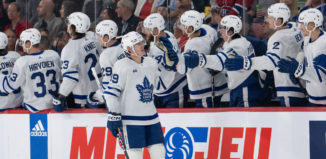Brain vs Brawn: The Derek Boogaard Story
On May 13th, 2011, Derek Boogaard accidentally overdoses on alcohol and prescription painkillers, and dies. He is twenty eight years old.
Four months later, two other enforcers, Rick Rypien and the retired Wade Belak, have died.
All three men had struggled with depression and/or substance abuse. All three men were under the age of forty.
There have always been enforcers in the NHL. A lot of people consider them a necessary part of the game, a kind of bodyguard to protect the star players. They stick up for their teammates night after night. It’s honourable. It’s how the game works. On average, over the last nine seasons, approximately six hundred games a season feature at least one fight.
In an article on the life and death of Derek Boogaard, the New York Times said “Sometimes fights are spontaneous combustions, a punch thrown to avenge a perceived cheap shot. Others are premeditated affairs, to settle simmering disputes — whether from last period or last season. Some are intended to reverse the momentum of a lopsided game. Some are a restless player’s way of proving himself to his team.” Not to discount the audience, who react viscerally, like Romans at the Coliseum, screaming for blood. A fight can be the thing that keeps people watching, has them shouting and cheering and pounding at the glass because fights are noble and honourable and exciting.
Right now, it seems like the fights themselves are so deeply intertwined with the NHL and with hockey in general that they’re almost impossible to separate out, to comment on as anything but Part Of The Game. But when you look closer, at players like Derek Boogaard, or Steve Moore, then you have to realize that there is a problem in the game, and it starts with two men dropping the gloves.
Derek Boogaard was an enforcer. He was a player who would have never made the NHL if not for his size and ability to fight. In 277 games over five seasons in the NHL, he had sixteen points, and almost 600 penalty minutes, including almost seventy fights. He was widely considered the toughest player in the NHL, and was cited as a reason for the retirement of fellow enforcer, Georges Laraque.
However, with this reputation came injury. Multiple concussions as a result of fighting led to personality changes, painkiller addiction, and possibly the biggest drug scandal in the NHL.
Boogaard’s mother received a phone call after his death from the Bedford V.A. Medical Center in Massachusetts, wanting to autopsy her son’s brain. This autopsy found evidence of highly developed Chronic Traumatic Encephelopathy, or CTE. This is a kind of degeneration similar to Alzheimers, and has been found in more than twenty former NFL players, as well as ex-pro boxers. However, they found degeneration far more advanced in Boogaard’s brain than of men twice his age. This would definitely have led to early onset dementia, and other more extreme personality changes, like the ones he started to exhibit months before his death. His family and friends could only watch as he became withdrawn, moody, and completely unlike the man they knew. “His demeanor, his personality, it just left him,” John Scott, a Wild teammate, said. “He didn’t have a personality anymore. He just was kind of — a blank face.”
Though part of it was certainly because of the head trauma, Derek Boogaard had other demons to fight. He suffered severe painkiller addiction from at least early 2009 right up until his death in 2011, and after his death, it was found out that during the 2008-09 season, he received eleven conflicting prescriptions from eight different NHL doctors, including one doctor not even affiliated with his team at the time, the Minnesota Wild. Over the course of the season, Boogaard was prescribed 370 painkillers containing hydrocortone, and this wasn’t including the ones he bought illegally, in a bar in Minneapolis. At the start of the 2009 season, he missed the first five regular reason games because he was in rehab for his addiction, and his performance declined so much that season that by the end of it, the Wild were forced to attempt to trade him.
He was picked up by the Rangers, but leaving Minnesota didn’t help him with his addiction, or his declining mental state. An incident on the ice in Ottawa left him concussed, depressed and in a great deal of pain. His father visited him, and was shocked by how unrecognisable his son was in the haze of his post-concussion syndrome, and by the number of pill bottles in his son’s bathroom, despite the Rangers being fully aware of both his painkiller addiction and his declining health. All the Rangers were interested in was him being in good enough shape to play and, more importantly, fight. They pumped him with painkillers just like the Wild did, and it ultimately killed him. He was found by his brothers in his apartment, dead from an accidental overdose of alcohol mixed with oxycodone.
Possibly the scariest thing about the Derek Boogaard tragedy is that he is not the only player who has suffered or been killed because of his hockey career. This is not an isolated incident in the NHL, and hasn’t been for a long time. Earlier, I mentioned Rick Rypien and Wade Belak, who died of similar causes only months apart.
Another notable incident is the Moore/Bertuzzi incident, where Colorado rookie Steve Moore was punched in the back of the head by Vancouver‘s Todd Bertuzzi, and was left with a concussion and three fractured vertebrae in 2004. He hasn’t played since. Ten years later, he’s still suffering the effects.
Alvin Blomqvist didn’t even make it to the NHL before he was forced to retire because of concussions sustained by fighting. He’s twenty years old, and has to hang up his skates permanently. He talks about it in this heartbreaking letter to hockeysverige.se (letter written in Swedish, partially translated here)
One of the dangers of playing a contact sport is the possibility of injuries like concussions. However, there is a difference between a concussion from an accidental body check, and the concussions suffered by Boogaard, Moore and Blomqvist in unnecessary, often brutal, fights.
The controversy over whether or not fights should be removed from the game, or penalized more severely (perhaps similar to Olympic rules) is not one that I’m going to get into in this article, but you simply can’t deny that had these players been better protected, or given more support after their injuries, that perhaps things would have turned out far differently, and players like Derek Boogaard would still be alive, even if they weren’t playing in the NHL.














